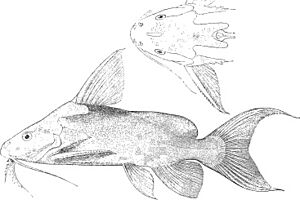Synodontis omias facts for kids
Quick facts for kids Synodontis omias |
|
|---|---|
 |
|
| Conservation status | |
| Scientific classification |
The Synodontis omias is a type of upside-down catfish. It lives in the Niger River area, found in countries like Guinea, Mali, Niger, and Nigeria. A German-born British zoologist named Albert Günther first described this fish in 1864. He found a specimen in Jebba, Nigeria. Not many of these fish have been found, and some experts think it might be the same species as another fish called S. budgetti.
What Does the Synodontis omias Look Like?
Like other Synodontis fish, the S. omias has a strong, bony head. This bony part goes all the way back to its first fin on its back.
Its head also has a special bony bump called a humeral process. This bump helps scientists tell different Synodontis species apart. For the S. omias, this bump is about one and a half times as long as it is wide. It also has two or three small spines pointing backward.
This fish has three pairs of barbels, which are like whiskers. One pair is on its upper jaw, and two pairs are on its lower jaw. The upper jaw barbels are straight and reach a little past its head. The outer pair of lower jaw barbels is longer than the inner pair. Both pairs of lower jaw barbels have short branches.
The fins on its back (dorsal fin) and sides (pectoral fins) have stiff spines at the front. The dorsal fin spine is long, about the same length as its head. It's slightly curved and smooth on the front, but rough on the back. The rest of the dorsal fin has seven soft rays. The pectoral fin spine is also long and rough on both sides.
The S. omias also has an adipose fin, which is a small, fleshy fin without rays. Its anal fin has five unbranched and seven or eight branched rays. The tail fin is deeply forked, meaning it splits into two parts, and both parts end in a long, thin tip.
All Synodontis fish have a special pad of teeth on the front of their upper jaw. This pad has several rows of short, chisel-shaped teeth. In S. omias, this tooth pad is short and wide. On its lower jaw, the teeth are attached to flexible stalks and look "s-shaped" or "hooked." The number of teeth on the lower jaw helps identify the species. The S. omias has about 40 to 50 teeth on its lower jaw.
The body of the Synodontis omias is a plain brownish color. This fish can grow up to about 36 centimeters (14 inches) long. Female Synodontis fish are usually a bit bigger than males of the same age.
Where Does the Synodontis omias Live and What Does It Do?
In the wild, the Synodontis omias lives in the inland Niger River basin. We don't know its full range yet.
Scientists don't know much about how most Synodontis species reproduce. However, they believe these fish likely lay their eggs during the flooding season. This usually happens between July and October. During this time, pairs of fish might swim together to spawn.
Synodontis fish are generally omnivores, meaning they eat both plants and animals. They eat things like insect larvae, algae, snails, clams, sponges, and even the eggs of other fish. These fish grow quickly in their first year, but their growth slows down as they get older.


